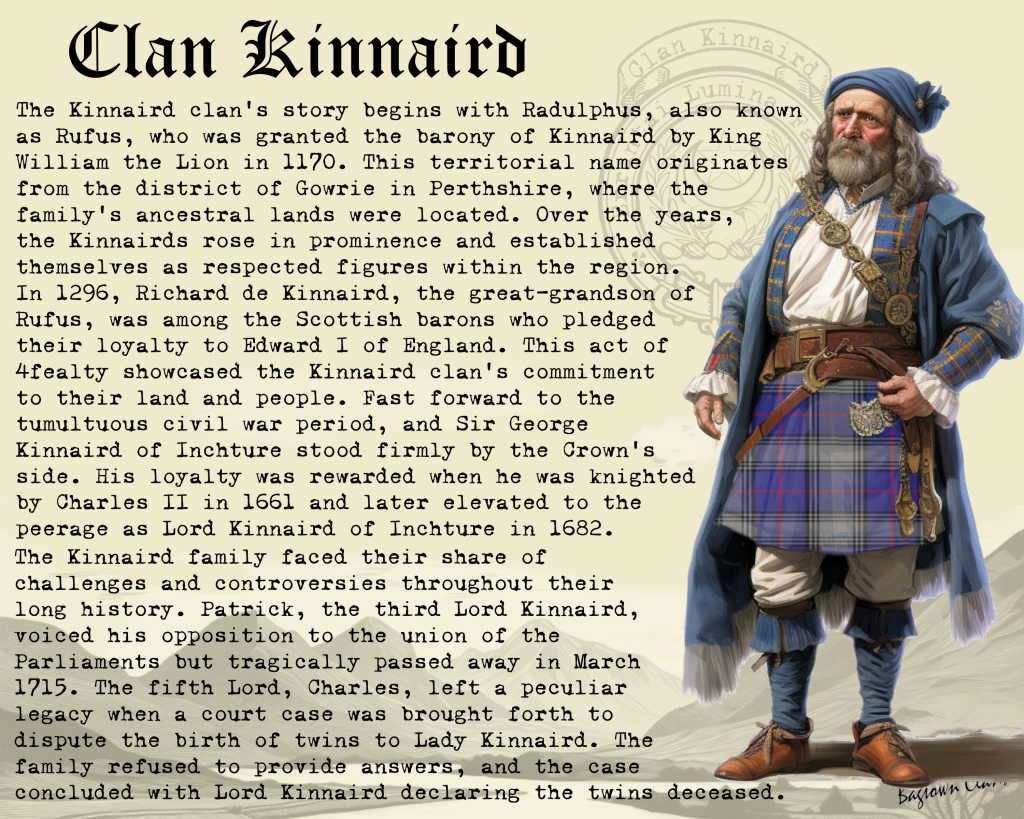Kinnaird Clan
|
|
CREST: A crescent arising from a cloud having a star issuing from between its horns, all within two branches of palm disposed in orle Proper MOTTO: Errantia lumina fallunt TRANSLATION: Wandering lights deceive VARIATIONS: N/A |
| The Kinnaird clan’s story begins with Radulphus, also known as Rufus, who was granted the barony of Kinnaird by King William the Lion in 1170. This territorial name originates from the district of Gowrie in Perthshire, where the family’s ancestral lands were located. Over the years, the Kinnairds rose in prominence and established themselves as respected figures within the region.
In 1296, Richard de Kinnaird, the great-grandson of Rufus, was among the Scottish barons who pledged their loyalty to Edward I of England. This act of fealty showcased the Kinnaird clan’s commitment to their land and people. Fast forward to the tumultuous civil war period, and Sir George Kinnaird of Inchture stood firmly by the Crown’s side. His loyalty was rewarded when he was knighted by Charles II in 1661 and later elevated to the peerage as Lord Kinnaird of Inchture in 1682. The Kinnaird family faced their share of challenges and controversies throughout their long history. Patrick, the third Lord Kinnaird, voiced his opposition to the union of the Parliaments but tragically passed away in March 1715. The fifth Lord, Charles, left a peculiar legacy when a court case was brought forth to dispute the birth of twins to Lady Kinnaird. The family refused to provide answers, and the case concluded with Lord Kinnaird declaring the twins deceased. The Kinnaird clan’s influence extended beyond politics and court dramas. One notable member, Sir George Kinnaird, the seventh Lord Kinnaird, served as one of the sixteen Scots representative peers in the House of Lords. His brother, Douglas, made a name for himself as an eminent banker and was known for his friendships with renowned poets Sheridan and Byron. Douglas also played a significant role in managing London’s prestigious Drury Lane Theater. The eighth Lord Kinnaird, born in 1780, enjoyed a successful political career, serving as a Member of Parliament and later as a representative peer of Scotland. He constructed Rossie Priory, a magnificent family mansion located in the picturesque Carse of Gowrie. In recognition of his contributions, the ninth Lord George Kinnaird was bestowed the title of Baron Rossie in 1831 and later created Baron Kinnaird of Rossie in 1860. His brother succeeded him as a Member of Parliament for Perth, ensuring the family’s continued honor and influence. Today, the Kinnaird family continues to reside on the lands they have proudly held for centuries. Their enduring legacy stands as a testament to their unwavering commitment to Scotland’s heritage and their significant contributions to politics, finance, and the arts. The story of the Scottish Clan Kinnaird showcases the resilience, loyalty, and enduring spirit that characterizes Scotland’s remarkable history. |
|
Citations:
|
|

Purchase @ Redbubble
Purchase @ Amazon.com
Purchase @ Amazon.co.uk

